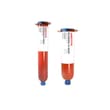LOCTITE ECCOBOND UV9060F
Harmonization Code : 3907.30.00.90 | Polyacetals, other polyethers and epoxide resins, in primary forms; polycarbonates, alkyd resins, polyallyl esters and other polyesters, in primary forms : Epoxide resins : Other
Main features
- UV & Moisture Cure
- Cures in shadowed areas
- Translucent light blue
Product Description
LOCTITE ECCOBOND UV 9060F no flow encapsulant is designed for local circuit board protection as a UV curing coating/encapsulant with secondary moisture cure in shadow areas. This product is fluorescent when viewed with ultraviolet (black) light.
LOCTITE ECCOBOND UV 9060F is a one component, fast curable translucent material that is easily dispensed without stringing. It is fluorescent under UV light and it typically used for assembly applications and the local protection of WLCSP and BGA on circuit boards.
Technical Specifications
| General Properties | |||||||
| |||||||
| Physical Properties | |||||||
| Viscosity Viscosity Viscosity is a measurement of a fluid’s resistance to flow. Viscosity is commonly measured in centiPoise (cP). One cP is defined as the viscosity of water and all other viscosities are derived from this base. MPa is another common unit with a 1:1 conversion to cP. A product like honey would have a much higher viscosity -around 10,000 cPs- compared to water. As a result, honey would flow much slower out of a tipped glass than water would. The viscosity of a material can be decreased with an increase in temperature in order to better suit an application | 11,000 mPa.s | ||||||
| Thermal Properties | |||||||
| |||||||
| Glass Transition Temperature (Tg) Glass Transition Temperature (Tg) The glass transition temperature for organic adhesives is a temperature region where the polymers change from glassy and brittle to soft and rubbery. Increasing the temperature further continues the softening process as the viscosity drops too. Temperatures between the glass transition temperature and below the decomposition point of the adhesive are the best region for bonding. The glass-transition temperature Tg of a material characterizes the range of temperatures over which this glass transition occurs. | 75 °C | ||||||
Additional Information
UV Cure
Light Source and Condition:
Metal halide doped spectrum UV lamp
- Lamp Power, W/in 300
- Distance between lamp to substrate, inches 4
- Irradiance UVA, EIT puck radiometer, mW/cmÇ 566
- Recommended Dose, seconds 5 to 25
Moisture cure occurs at ambient temperature and humidity.
*Cures at least 0.25 inch under optimum conditions.



